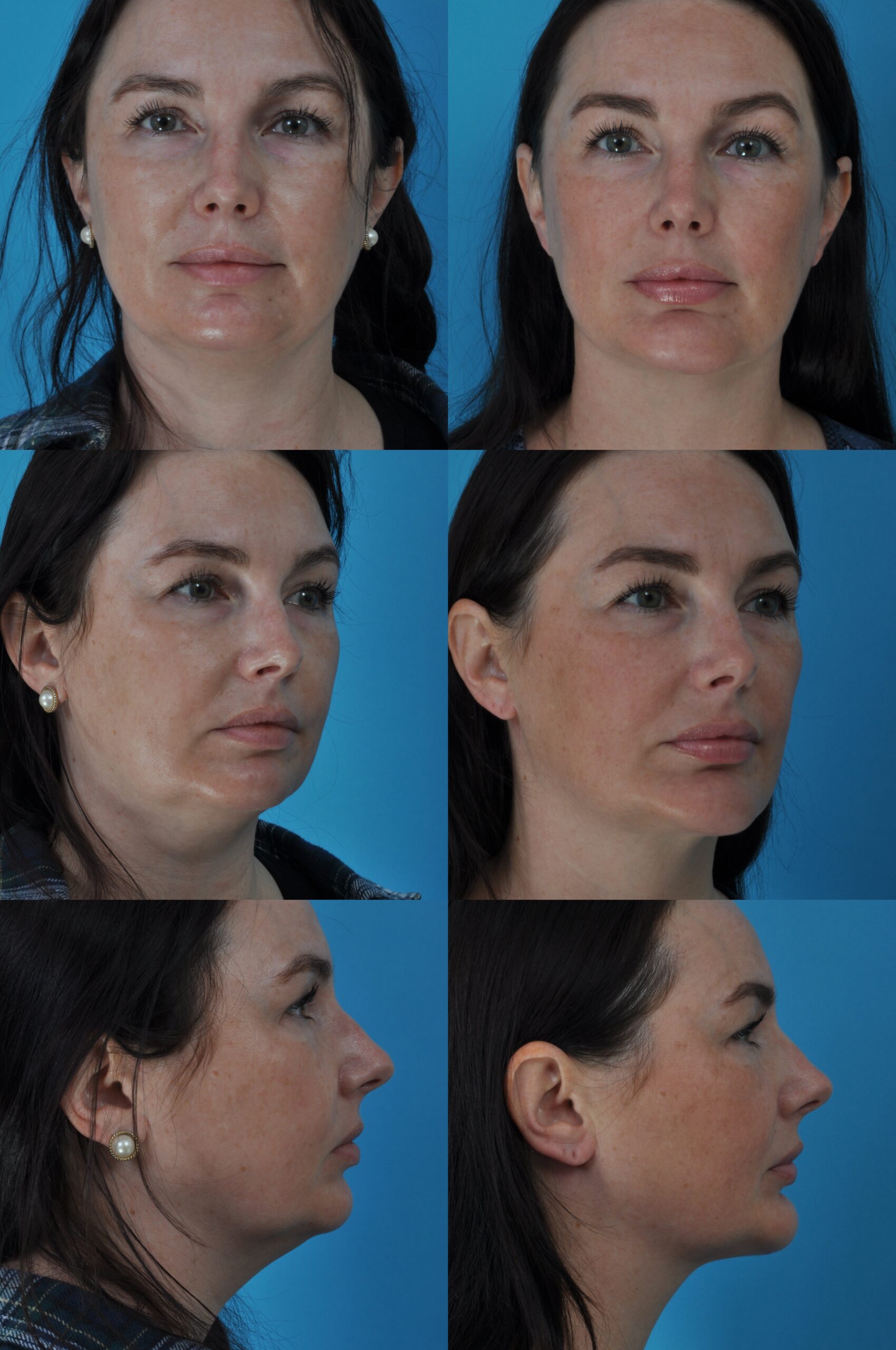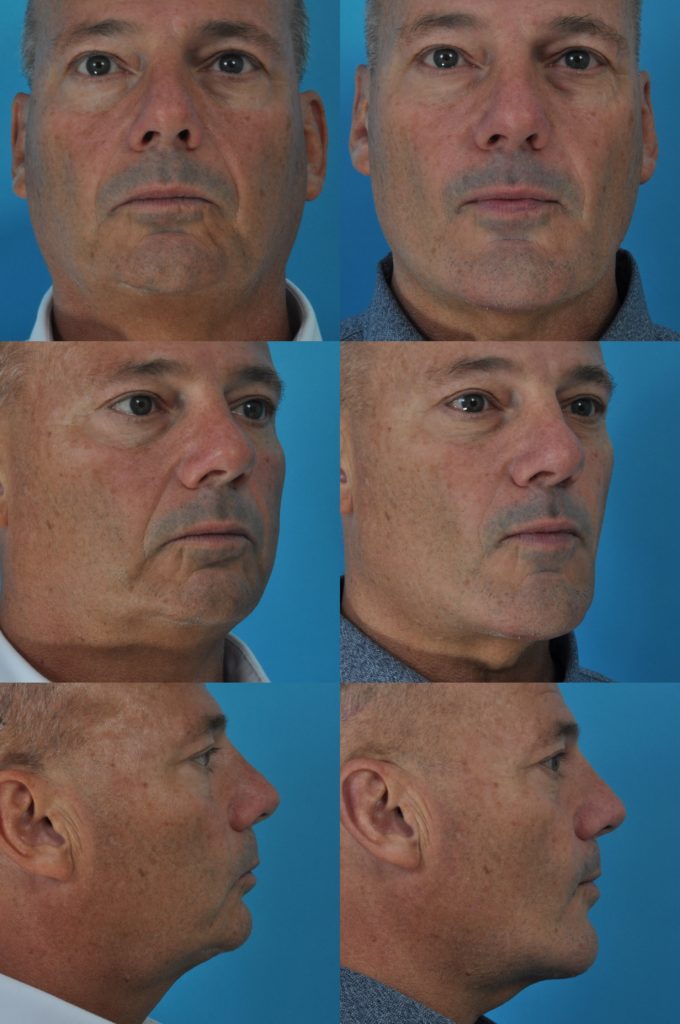INTRODUCTION
A balanced facial profile is desirable. In fact, it is difficult to look very attractive without jawline definition and adequate chin projection. Almost all popular movie stars or models, past or present, have a well-defined jawline, whether natural or enhanced. A few examples—Michelle Pfeiffer, Angelina Jolie, Rob Lowe, Cary Grant, any actor who’s played James Bond and any actress who’s played a Bond girl.
The face can be divided into thirds (See photo). The lower third balances the upper and middle thirds. For a pleasing profile, the chin should fall into alignment with the most projecting points on the upper and lower lips, called Reidel’s plane.
Unfairly, a strong chin is thought to be associated with strong character. The chairman of the board, the warrior-king, and the quarterback hero are all portrayed by men with strong chins in movies. Look at an ad for any branch of the U.S. military and you will see a strong chin. The same is true for superheroes. Idealized portraits of Napoleon in battle take almost cartoonish liberties in exaggerating his chin.
Many people inherit a recessed chin. Sometimes a small chin may be associated with improper alignment of the teeth (“malocclusion”), in which case orthodontic treatment is needed to adjust their position. If an overbite cannot be corrected with braces, orthognathic surgery is needed, which involves breaking the jaw bone and advancing it forward. However, patients with cosmetic concerns who have a normal occlusion do not need jaw-breaking surgery. A chin implant is used to augment the lower third of the face, balancing the lower third with the upper and middle thirds, and improving facial proportions. It is a procedure that plastic surgeons can usually do well and reliably, and without a difficult recovery.
I commonly point out any deficiency of the lower face in patients inquiring about other cosmetic procedures. I am not hesitant to do so because of the profound benefit that this procedure can give to facial balance. A chin augmentation and submental lipectomy complement each other in defining the jawline.
Chin Implants
Chin implants used in the 1980s were often quite short, limited to the chin, and tended to produce a pointy chin. They also were prone to moving around. Modern implants wrap around the jawline, helping define the jawline along the sides, and do not move after healing. They are made of solid silicone, a material that is inert and safe to implant. The procedure is also reversible. If a patient decides later that he or she does not want the implant, it is easy to remove. This rarely happens because patients prefer their appearance with the implant. It feels totally natural and is not fixed with screws. It is placed in a pocket made under the lining of the mandible, the periosteum. Scar tissue forms and holds the implant securely in place. Because the implant is flexible, the incision does not need to be any longer than the incision used to perform a submental lipectomy.
Absorption of the bone under implants has been reported, but this does not seem to present a practical problem. I’ve followed patients with chin implants for over a decade with no noticeable changes on their profile views
Jawline Augmentation
The jawline may be augmented with or without augmentation of the chin. When done on its own, this implant has been called a jowl implant, describing augmentation of the jawline on either side of the chin. However, the term “jowl” implant is an unfortunate name because the word “jowl” commonly refers to the undesirable soft tissue hanging over the edge of the jaw. No one would want to augment this problem, which is treated with a facelift. Instead, in this context, “jowl” refers to the bony jawline itself on either side of the chin (anatomically, the “body” of the mandible). To avoid confusion, I prefer the description “jawline” augmentation.
The aesthetic importance of an unbroken jawline is increasingly being recognized. Commonly, there is a depression called a prejowl depression or a prejowl sulcus on either side of the chin that seems to become more pronounced with aging. If this depression is filled in, the chin tends to blend in with the jawline, which is appealing to the eye. Implants manufactured today are longer than ones used in the past, wrapping around the jaw to help achieve jawline continuity. Jawline augmentation can also serve to camouflage soft-tissue jowls by filling in the valley between the jowl and the chin on either side. This effect can be a temporary measure for those patients who are not yet ready for a facelift (See S.H., Patient Photographs).
Female Patient Photos
E.O., Age 33
Procedure: submental lipectomy and chin augmentation.

Before, 3 months after
C.V., Age 36
Procedure: chin augmentation.

Before, 6 months after
J.T., Age 37
Procedure: chin augmentation and submental lipectomy.

Before, 8 months after
Improved Facial Proportions
D.S., Age 37
Procedure: Chin augmentation, submental lipectomy, upper and lower blepharoplasties, septorhinoplasty, fat injection (12 cc.), excision of nasal skin lesion, and erbium laser resurfacing

Before, 5 months after
S.B., Age 38
Submental Lipectomy and Chin Augmentation
4 months
Jawline Implant
S.H., Age 45
Procedure: Submental lipectomy, jawline augmentation, upper and lower blepharoplasties, and revision of right cheek scar.

Before, 3 months after
D.C., Age 48
Procedure: Jawline augmentation, facelift, setback otoplasties, and facial fat injection (18 cc).

Before, 3 months after
Male Patient Photos
Balanced Profile
R.H., Age 37
Procedure: Submental lipectomy, chin augmentation, and rhinoplasty.

Before, 2 years after
J.G., Age 40
Procedure: Jawline augmentation and submental lipectomy.

Before, 3 months after
M.D., Age 40
Procedure: Chin augmentation, submental lipectomy, facial fat injection (18 cc), excision of facial skin lesions and scar revision of left eyebrow.

Before, 1 year after
D.G. Age 46
Procedure: Chin augmentation, facial fat injection (27.5 cc), setback otoplasties, and submental lipectomy.

Before, 1 month after
Under I.V. anesthesia, an incision is made in the crease immediately under the chin. A pocket is made under the lining of the bone (periosteum). Care is taken to follow the lower border of the jaw so as to avoid injury to the mental nerves that exit the mandible on either side of the chin. The implant is then selected and customized by trimming it to provide more projection where it is needed and less where it is not needed. For example, the patient may need more filling in along the sides of the jaw and less in the chin, in which case the middle section of the implant is trimmed. The muscle that has been lifted off the jawline is then used to cover the implant and the skin is closed. Usually, a submental lipectomy is performed immediately before insertion of the implant using the same incision. Either a single continuous “running” suture or several interrupted sutures are used and these are taken out between 3 and 7 days after surgery.
Sometimes patients ask if the incision can be made on the inside of the mouth so there is no visible scar. Although it is possible to do so, the external approach is preferred because there is less dissection of the muscle off the bone and therefore less risk to lower lip function. Also, the exposure is cleaner than working through the mouth, which is not a sterile field. Furthermore, I usually perform liposuction under the chin and tighten the platysma muscle in the neck, procedures that require an incision below the chin anyway. It makes sense to use the same incision to insert the implant. The scar is kept as short as possible and is usually well-concealed in the crease under the chin.
Patients often wonder what holds the implant in place and prevents it from moving around. They are sometimes surprised to learn there are no screws to secure it. Ideally, the pocket is made just large enough for the implant so it has nowhere to move. The body forms scar tissue around the implant to hold it in position. By about 2 weeks after surgery, the implant is solidly fixed in place. One patient of mine had the opportunity to test this fixation when she was kicked in the chin by a mule a few months after surgery! She is convinced the implant absorbed the shock and protected her from a jaw fracture.
The jowl implant is much like the chin implant, but tapered centrally, in the area of the chin. These patients require filling in along the jawline and very little, if any, increased projection of the chin. In fact, I use the same implants that I use for chin augmentation and simply reduce the central portion in the operating room before inserting the implant. The operative technique, postoperative course, instructions and complications are the same as for chin augmentation.
Patients wake up wearing a chin strap with a gauze dressing tucked inside. The chin strap and dressing are removed the day after surgery. The is swelling and soreness of the chin. The skin may be numb. Sometimes the muscle that acts to pull down the corner of the mouth on one side is temporarily weakened. Patients may experience some temporary difficulty articulating. The recovery is very similar to the recovery after a submental lipectomy, although there is more soreness and swelling of the chin. The sutures come out in 3 to 7 days.
Chin Numbness
The mental nerve comes out of its hole (“foramen”) just above the level of the implant. This nerve may be traumatized by the surgery, or there may be some pressure from the implant on the nerve, causing numbness of the chin. Usually this numbness is temporary.
Infection
Fortunately, the facial tissues have an excellent blood supply and are resistant to infection. If antibiotics prove ineffective, the implant is removed and replaced at a later date. Fortunately, this is seldom necessary.
Malposition
Because the implant is not screwed in place, movement is possible during the first few weeks. About 2 weeks after surgery, the implant is securely fixed by the scar tissue that envelopes it and is unlikely to move. It is possible that the implant may heal in a slightly asymmetrical fashion, such that one side of the implant may lie a little higher or lower than the jawline. Occasionally, patients can feel the implant with their tongue on one side. This means the implant has shifted and needs to be repositioned.
Overcorrection/Undercorrection
Before surgery, patients worry about overcorrection. Women in particular do not want an over-emphasized, masculine chin. They don’t want to look like Jay Leno. I reassure them that, as in other types of cosmetic surgery, I will not overdo it. It is better for the chin to be slightly receded and still natural-looking than overdone. Undertreatment is seldom a problem.
Accentuation of the Chin Crease
If a patient has a deep chin crease, an implant may make it look even deeper. In such patients, it may be best to avoid using an implant. I have had success in using an implant and injecting this crease with fat simultaneously.
Getting Back to Normal
The postoperative care after chin and jawline augmentation is much the same as for a submental lipectomy (See Submental Lipectomy) and, of course, the two procedures are frequently done together. There tends to be more swelling after the combined procedure because of the extra dissection along the jawline for implant insertion.
Q: What is the implant made of?
A: It is made of a hard form of silicone, an inert material that has been used in the human body for decades. This solid form of silicone is unlike the gel form that is used in breast implants. There is no risk of rupture or leak of silicone into the tissues.
Q: What holds the implant in place?
A: A pocket is made under the lining of the bone of the mandible. The implant is placed in this pocket. Scar tissue forms around the implant, holding it in place. Once this scar tissue has formed, the implant does not move. It adheres securely to the mandible. Therefore, screws are not required. There is a period of about 2 weeks after surgery when it is important not to bump the implant to avoid displacement.
Q: How long do I have to wear a strap around my head?
A: Just overnight. However, you can wear it longer if you like for comfort and to reduce swelling, particularly at home.
Q: Does it hurt?
A: A chin augmentation hurts more than a submental lipectomy alone, probably because the lining of the bone (periosteum) is lifted up, which is not done in a submental lipectomy. Even so, a chin augmentation causes only a moderate level of discomfort that is typically well-controlled with pain medication taken the first few days after surgery.
Q: I don’t want to have a chin like Jay Leno. How can I be sure it’s not going to be too big?
A: Like other plastic surgical procedures, overtreatment is best avoided. It is better to “under-do” a chin augmentation than overdo it. I have treated a subset of male patients who desire an accentuated “superhero” chin, with a square-shaped chin implant, but these patients are in the minority.
Q: Another doctor told me the bone may get absorbed under the implant.
A: Bony resorption under implants has been described. However, this does not seem to present a problem for patients. Many patients have had their implants for a decade or more with no noticeable loss of projection. Any bone absorption under an implant is unlikely to be significant enough to require additional surgery. I have yet to replace an implant because of bony resorption.
Q: I don’t like the idea of an artificial material in my body. Are there alternatives?
A: In general, North American surgeons prefer to use the patient’s own tissue rather than an artificial material. The obvious exception is breast implants. However, the chin is a place where an artificial material makes sense, too. Surgery to move the jaw forward is unnecessary in most cosmetic cases and much more traumatic to the tissues. Complications can be significant. For example, bony surgery has a high incidence of nerve injury that can cause permanent numbness of the chin. Another advantage of an implant is that it can be removed easily if there is a problem. Despite its safety, there are patients who simply don’t want an implant and that’s okay. In these patients, I recommend fat injection to augment the chin and jawline. This can sometimes mimic the result of an augmentation using an implant, but there will be some degree of fat absorption, so the result is not quite as predictable.
Q: What if I don’t like it?
A: This is one of the few procedures in plastic surgery that is truly reversible. The implant can be easily removed under local anesthetic or a very short intravenous anesthetic.


